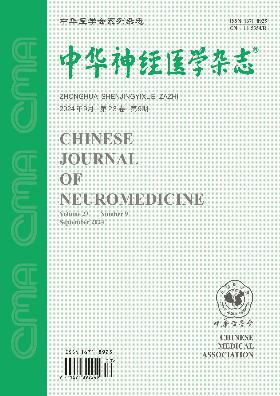Deep brain stimulation of subthalamic nucleus combined with drugs in two patients with Parkinson's disease related neuroleptic malignant syndrome
Q4 Medicine
引用次数: 0
Abstract
Objective To explore the role of deep brain stimulation of subthalamic nucleus (STN-DBS) in treatment of Parkinson's disease (PD) related neuroleptic malignant syndrome (NMS). Methods The medical history, clinical features, STN-DBS programmed treatment process and treatment results of two patients admitted to our hospital in December 2014 and November 2018 were retrospectively analyzed. Results Two patients with post-operative STN-DBS were evoked by dose-reduced treatment of anti-parkinsonian drugs, and presented with high fever, disorder of consciousness, aggravation of the original parkinsonism, and increase of creatine phosphokinase, which were not correlated with outcomes of infection. After admission, anti-parkinsonian drugs and other supportive therapies were supplemented; STN-DBS modulation were given to improve the symptoms; the final parameters of patient one were the left (C+, 2-, 1-), pulse width 110 μs, frequency 200 Hz, and strength 3.8 V; the right side (C+, 6-, 5-), pulse width 110 μs, frequency 200 Hz, strength 4.4 V; and those of patient two were the left (C+, 3-), pulse width 60 μs, frequency 130 Hz, strength 2.0 V; right side (C+, 6-), pulse width 80 μs, frequency 160 Hz, and strength 2.8 V. Both patients were cured, but their motor function and self-care ability were severely impaired. Conclusion STN-DBS may play an important role in the treatment of PD related NMS. Key words: Parkinson's disease; neuroleptic malignant syndrome; Drug withdrawal; Deep brain stimulation of subthalamic nucleus丘脑下核深部脑刺激联合药物治疗帕金森病相关抗精神病药恶性综合征2例
目的探讨丘脑下核深部脑刺激(STN-DBS)治疗帕金森病(PD)相关抗精神病药恶性综合征(NMS)的作用。方法回顾性分析我院2014年12月和2018年11月收治的2例患者的病史、临床特点、STN-DBS程序化治疗过程及治疗结果。结果2例术后STN-DBS患者经抗帕金森药物减量治疗后出现高热、意识障碍、原有帕金森症状加重、肌酸磷酸激酶升高等症状,与感染结局无关。入院后补充抗帕金森药物及其他支持治疗;给予STN-DBS调节以改善症状;患者1最终参数为左(C+、2-、1-),脉宽110 μs,频率200 Hz,强度3.8 V;右侧(C+、6-、5-),脉宽110 μs,频率200 Hz,强度4.4 V;患者2为左(C+, 3-),脉宽60 μs,频率130 Hz,强度2.0 V;右侧(C+, 6-),脉冲宽度80 μs,频率160 Hz,强度2.8 V。两例患者均治愈,但运动功能和生活自理能力严重受损。结论STN-DBS可能在PD相关NMS的治疗中发挥重要作用。关键词:帕金森病;抗精神病药恶性综合征;停药;丘脑底核深部脑刺激
本文章由计算机程序翻译,如有差异,请以英文原文为准。
求助全文
约1分钟内获得全文
求助全文
来源期刊

中华神经医学杂志
Psychology-Neuropsychology and Physiological Psychology
CiteScore
0.30
自引率
0.00%
发文量
6272
期刊介绍:
 求助内容:
求助内容: 应助结果提醒方式:
应助结果提醒方式:


